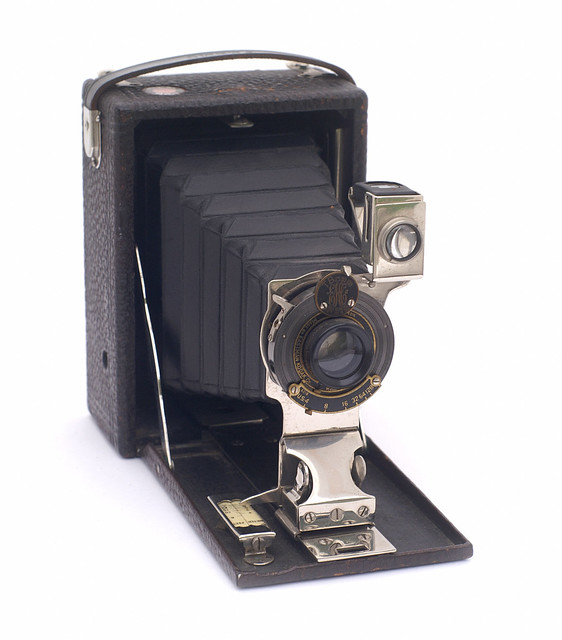Difference between revisions of "Film Premo"
m (moved Film Premo No.1 to Film Premo: The No. 1 is one of three models, that differ more or less only in the size of the film pack; so easy to make one page cover all three) |
(Edited to include two other models (different film pack sizes); noted packs are 12-exp) |
||
| Line 8: | Line 8: | ||
}} | }} | ||
| − | [[Eastman Kodak]]'s '''Film Premo No.1''' | + | [[Eastman Kodak]]'s '''Film Premo''' folding cameras use film packs, for 12 exposures. The camera was patented in 1903 and produced in 1906. It was made in three sizes: |
| + | * The '''Film Premo No. 1''' uses 3¼×4¼ inch film packs ([[Plate Sizes|quarter-plate format]]). | ||
| + | * The '''Film Premo 3A''' uses 3¼×5½ inch packs (Postcard size). | ||
| + | * The '''Film Premo 4×5''' uses 4×5 inch packs. | ||
| − | It has a Rochester Optical Co. Planatograph lens and [[Ball Bearing Shutter]], giving speeds 1/25 - 1/100 second, plus 'T' and 'B'. This can be released manually with the lever, or with a pneumatic release (i.e. a rubber bulb and tube). The shutter is not synchronised for flash, but the manual describes the use of flash, using 'T' or 'B' shutter with a plate for burning flash powder.<ref name=Butkus>[http://www.butkus.org/chinon/kodak/kodak_film_premo/kodak_film_premo.htm Instructions for using the Film Premo No. 1] downloadable as a pdf from [http://www.butkus.org/chinon/ Orphan Cameras].</ref> | + | The Film Premo seems to be a budget version of the '''Kodak Pocket Premo C''' which retained more of the quality of [[Rochester Optical Co.|Rochester Optical]]'s original Premo cameras (wooden front door). [[George Eastman]]'s idea to popularize photography may have inspired [[Kodak]]'s camera engineers to make this cheaper variant after Kodak had bought Rochester Optical in 1903. |
| − | The aperture is calibrated in [[F-stop#Uniform System stop numbers|Uniform System]] stop numbers, from US stop 4 (f/8) to 128 (f/45). The lens standard is simply pulled forward to focus using the scale on the bed (squeezing the clips on each side to release | + | |
| + | It has a Rochester Optical Co. Planatograph lens and [[Ball Bearing Shutter]], giving speeds 1/25 - 1/100 second, plus 'T' and 'B'. This can be released manually with the lever, or with a pneumatic release (i.e. a rubber bulb and tube). The shutter is not synchronised for flash, but the manual describes the use of flash, using 'T' or 'B' shutter with a plate for burning flash powder.<ref name=Butkus>[http://www.butkus.org/chinon/kodak/kodak_film_premo/kodak_film_premo.htm Instructions for using the Film Premo No. 1] downloadable as a pdf from [http://www.butkus.org/chinon/ Orphan Cameras]. In the manual, Kodak describes itself as 'the successor to Rochester Optical Co.' several times.</ref> | ||
| + | |||
| + | The aperture is calibrated in [[F-stop#Uniform System stop numbers|Uniform System]] stop numbers, from US stop 4 (f/8) to 128 (f/45). The lens standard is simply pulled forward to focus using the scale on the bed (squeezing the clips on each side of the standard to release it to slide on the bed): it focuses down to six feet. The user's manual advertises a kit of accessories, including close-up, telephoto and wide-angle supplementary lenses.<ref name=Butkus></ref> | ||
There is a [[brilliant finder]], which rotates for use in both portrait and landscape orientation. | There is a [[brilliant finder]], which rotates for use in both portrait and landscape orientation. | ||
Revision as of 12:25, 17 September 2011

|
| image by Steve Harwood (Image rights) |
Eastman Kodak's Film Premo folding cameras use film packs, for 12 exposures. The camera was patented in 1903 and produced in 1906. It was made in three sizes:
- The Film Premo No. 1 uses 3¼×4¼ inch film packs (quarter-plate format).
- The Film Premo 3A uses 3¼×5½ inch packs (Postcard size).
- The Film Premo 4×5 uses 4×5 inch packs.
The Film Premo seems to be a budget version of the Kodak Pocket Premo C which retained more of the quality of Rochester Optical's original Premo cameras (wooden front door). George Eastman's idea to popularize photography may have inspired Kodak's camera engineers to make this cheaper variant after Kodak had bought Rochester Optical in 1903.
It has a Rochester Optical Co. Planatograph lens and Ball Bearing Shutter, giving speeds 1/25 - 1/100 second, plus 'T' and 'B'. This can be released manually with the lever, or with a pneumatic release (i.e. a rubber bulb and tube). The shutter is not synchronised for flash, but the manual describes the use of flash, using 'T' or 'B' shutter with a plate for burning flash powder.[1]
The aperture is calibrated in Uniform System stop numbers, from US stop 4 (f/8) to 128 (f/45). The lens standard is simply pulled forward to focus using the scale on the bed (squeezing the clips on each side of the standard to release it to slide on the bed): it focuses down to six feet. The user's manual advertises a kit of accessories, including close-up, telephoto and wide-angle supplementary lenses.[1]
There is a brilliant finder, which rotates for use in both portrait and landscape orientation.

|
| Film Premo with box and instructions image by PhotoShop Guru (Image rights) |
References
- ↑ 1.0 1.1 Instructions for using the Film Premo No. 1 downloadable as a pdf from Orphan Cameras. In the manual, Kodak describes itself as 'the successor to Rochester Optical Co.' several times.
Links
- Film Premo No.1 on www.collection-appareils.fr by Sylvain Halgand
- Image of the predecessor Kodak Pocket Premo C at Caméra de Collection [1]